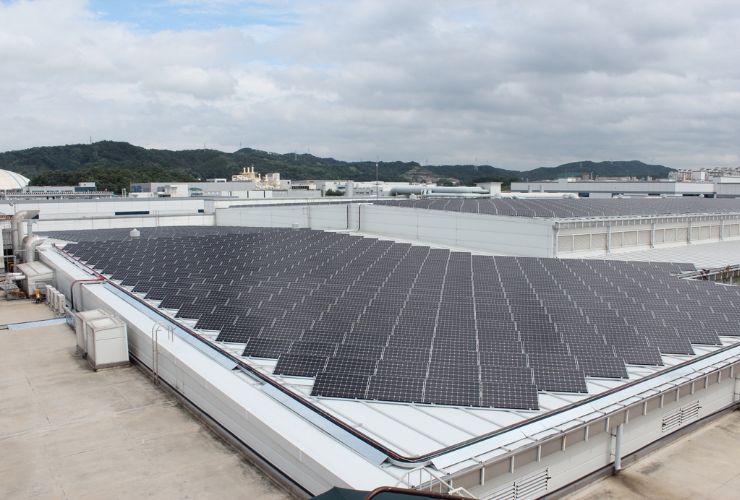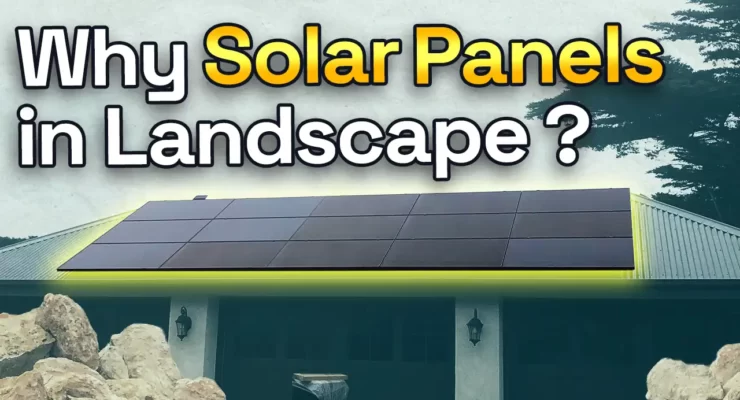Fast read
Portrait and landscape solar panels are the same product, it's just the installation direction that varies.
Landscape solar panels can offer certain advantages depending on the specific circumstances of the installation. They are suitable when the roof has more width than height, allowing for the installation of more panels and increasing the overall power output.
However, portrait panels tend to be easier to install, and cand are therefore preferred. They also need less rail per panel and are therefore a little cheaper.
Factors such as panel efficiency, installation aesthetics, and location-specific considerations should be taken into account when deciding between landscape and portrait solar panels. An experienced solar professional usually recommends which direction is the most advantageous for your particular roof.
What exactly are landscape solar panels?
Over the last decade, solar energy has grown exponentially because of its clean and renewable energy supply, appealing to consumers both financially and environmentally. If you are into solar and have been looking at finally investing in some panels, you may wonder why some panels on the roof are installed in a portrait format, and some are installed in landscape.
Are landscape solar panels a different model?
The traditional, more popular option for solar panel installation is a vertical, also known as a portrait PV panel orientation. However, from time to time, one will walk past a roof and notice that the panels are installed in a landscape way.
Landscape vs portrait solar panels Explained
Portrait solar panels, otherwise known as the traditional solar panel installation, are the more common of the two. About 95 % plus of Australian homes would have the panels installed that way. One of the reasons is that the balance of the system rail needed behind a residential panel in a portrait install is only around 2 metres per panel (1m on the top and 1 m on the bottom).
Installed in landscape position, it needs at least 60% more rail, e.g. around 3.6 metres (1.8 top and bottom). So a landscape solar panel installation will cost more in PV rail components and brackets, as more brackets are needed to fasten the more extended rail. As the bracket installations take time, the labour cost is also higher for a landscape solar panel installation than the traditional portrait set-up.
In Australia, solar sales are extremely cost-competitive, so salespersons and installers will not easily suggest a solution that adds to the cost without having some significant benefits.

So why does it happen?
Various reasons may have led a solar installer to install solar panels with a landscape orientation. The fact that that particular roof had more width than height may be one factor, making landscape orientation the more sensible option. In this situation, a landscape solar panel orientation would enable the installation of more solar panels, hence allowing for the installation of a larger PV system with a bigger kW capacity. Larger solar power systems generate more power output.
Landscape-oriented solar panels are typically used and found in areas that are tighter in space and where installing them vertically would be difficult. Installing solar panels in landscape orientation can also lessen the effects of shading as this helps avoid a particular shaded part of a roof or the shading from a nearby antenna or satellite dish.
Popular in commercial tilt systems
Landscape tilt frame orientation may also be advantageous for placing solar panels on flat-roofed commercial structures because it enables the installation of more panels on the roof. This is because the panel does not stand up too high from the roof, as in a portrait tilt.
The wind load on the panel is less, and the panel throws a lower shadow onto the panels installed behind the initial row of the PV panel. In commercial setups, it’s crucial to avoid this self-shading scenario at all costs. It leads to significant generation loss, and the overshadowing puts stress on the panels’ bypass diodes.

When is a landscape solar panel position the clear winner?
The ideal panel position is when they face True North, allowing lots of sunlight to hit the panels throughout the day. In some residential roofs, the North side is full of gables and other structures, or it faces the street, and the homeowner wants to avoid seeing panels when they drive into their driveway.
So sometimes, especially in narrow homes, the North-East or North-West facing roofs are long but not high enough to accommodate a portrait install, or they need to be higher to accommodate two portrait rows but high enough to fit one portrait and one landscape row.
Another option to consider if your roof only offers limited portrait positions is to buy more efficient panels. Such panels required overall less roof space.
Often ground-mounted solar PV systems use landscape solar panels
Landscape solar panel installs are also popular for free-standing ground-mount solar structures. The higher the structure, the more the wind load and the stronger the rail foundations will need to be. So installers prefer a broader structure that does not tower too high above the ground like in the photo below.

Aesthetics can be important
It is also interesting to consider the final look of the solar PV power station. For example, if one has a flat roof, one could install the panels flat on the roof so no one sees them from the ground. One disadvantage of this solution is that one will spend more on solar panel cleaning, a flat panels have the dust and dirt washed off less regularly.
Alternatively, consider a tilt frame solution. When panels are arranged in a tilt and landscape orientation, they sit lower, reducing their visibility from the ground compared to portrait panels. Their wind load exposure will also be lower if they sit in a side-on position. If you do not want to see tilt frames on a roof from the ground, a sideways-installed panel offers a potential solution.
In summary
Landscape solar panels can be a good option for some solar panel systems. Carefully check out the pros and cons of panel positions and consult with a solar professional to determine whether they are the best choice for your system. By considering the position and angle of the panels and the system’s aesthetics, you can decide which way is correct for you.



